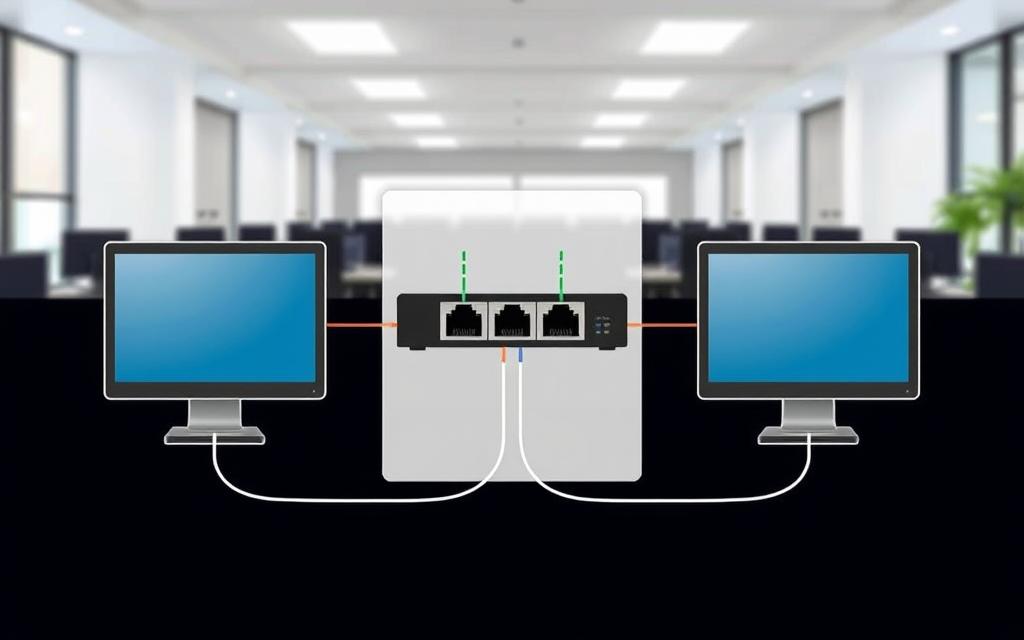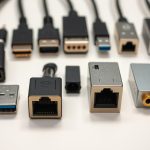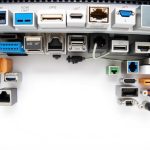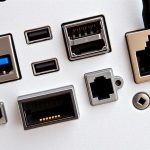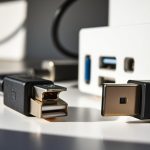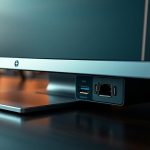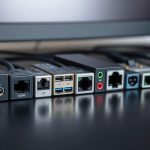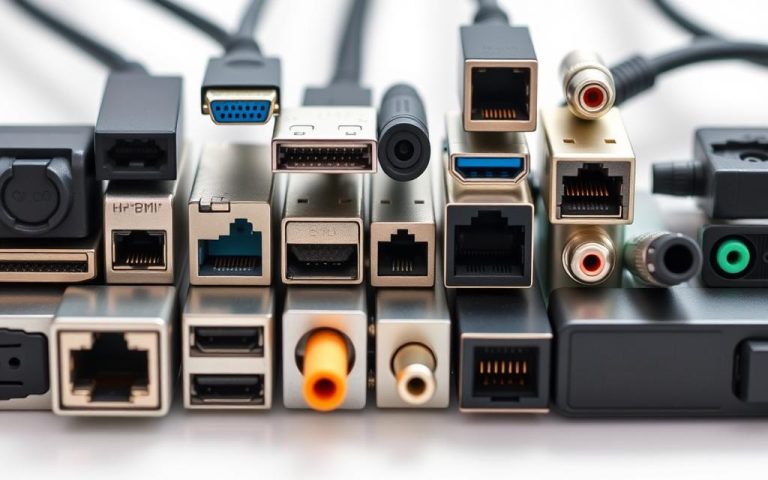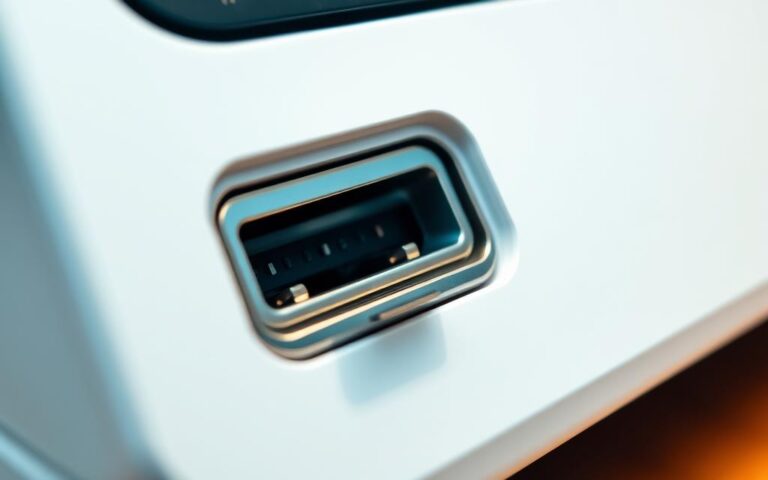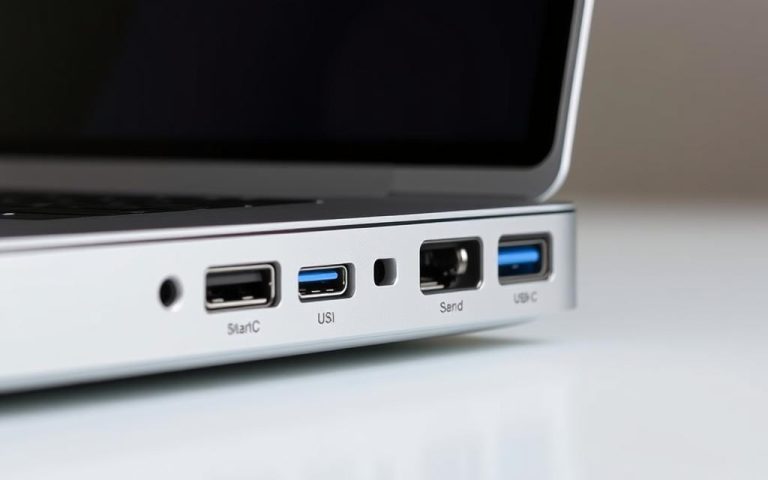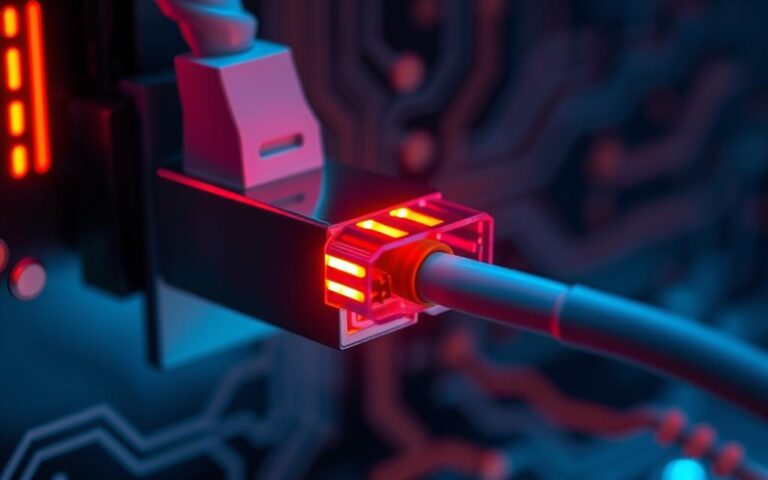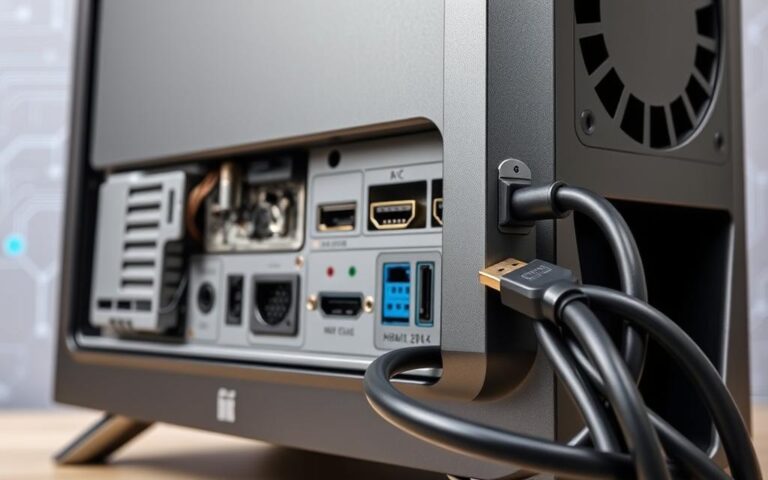How to Connect Two Computers to a Single Ethernet Port
In our world today, connecting two computers to one Ethernet port is crucial. This is especially true in places with many devices that need to join the same network. You might be in a bustling workspace or sorting out tech at home.
Sharing network access well is key. We’ll look at using a network switch, an Ethernet hub, and a splitter. These tools help hook up two computers. With this knowledge, you can boost your network for better teamwork.
Understanding Ethernet Connections
Ethernet connections are vital for modern networks, enabling devices to talk to each other. It’s crucial to know the types of Ethernet to make devices work well together. Choosing the right Ethernet ports can make a network more efficient.
Types of Ethernet Connections
Various Ethernet connections suit different networking needs:
- Network Switches: These help send data straight to the right device in busy networks. They’re great for when many devices need to connect at once.
- Ethernet Hubs: Hubs send data to all devices, which can slow down a busy network. They look like switches but aren’t as efficient in heavy traffic.
- Ethernet Splitter Cables: These cables link two devices to one Ethernet port. However, they only let one device use the network at a time.
- Cable Sharing Kits: These kits allow two devices to share a single cable effectively. They’re ideal for connecting more devices without losing speed.
- Routers: Mostly used to access the internet, routers can also increase the number of connected devices. They act like Ethernet splitters.
Ethernet Port Functionality
Understanding Ethernet port functionality is key for connecting devices to a network. These ports transfer data across devices. Knowing about different connections can help in picking the right gear. Experts suggest getting professional help with wiring and networking to ensure the best performance and avoid problems.
Assessing Your Networking Needs
Before you link multiple computers together, knowing your networking needs is crucial. To figure out what you need, look at the number of devices, the speed you want, and how you might grow in the future. A detailed review of your requirements will guide you.
Determining the Right Equipment
Choosing the right gear means finding devices that match your connection needs. For high-speed links, Ethernet cables like the 10/100/1000 Cat 6 are best. Wired networks, faster and more secure than wireless, range from 10 Mbps to 1000 Mbps in transfer rates. You may just need a switch, or for complex setups, a router or hub is necessary.
Evaluating Connection Requirements
Understanding your needs makes setting up an effective network easier. Important aspects include the need for speed, reliability, and the devices you’re using. If quick data transfer is key, consider a Gigabit Ethernet, reaching speeds up to 1 Gbps. For a blend of wired and wireless, certain routers, switches, and Ethernet cables can help. Check out this guide for a rundown on computer ports and their uses
| Network Type | Speed | Reliability | Installation Cost |
|---|---|---|---|
| Wired | 10-1000 Mbps | High | Higher initial investment |
| Wireless | 10-600 Mbps | Medium | Generally lower |
| Hybrid | Varies | Moderate to High | Variable depending on setup |
Taking the time for a complete networking needs assessment will ensure your setup meets current and future requirements. It helps in making smart choices to perfect your network.
How to Connect Two Computers to a Single Ethernet Port
Connecting two computers with one Ethernet port can boost your network skills. It’s efficient for device communication. Use an Ethernet network switch to link multiple computers at once. This text explains the setup process and the switch’s benefits.
Using an Ethernet Network Switch
To start, you’ll need some equipment. An Ethernet network switch helps devices talk without issues. Here’s what to do:
- Plug the Ethernet switch into a power source.
- Connect an Ethernet cable from your router to a switch port. This creates the main link.
- Then, use more Ethernet cables to join each computer to the switch.
- Make sure every computer is on and set up for sharing files if needed.
If your computer doesn’t have an Ethernet port, get a USB Ethernet adapter. You can find them in tech shops or online. Most new devices don’t need a special crossover Ethernet cable for connection.
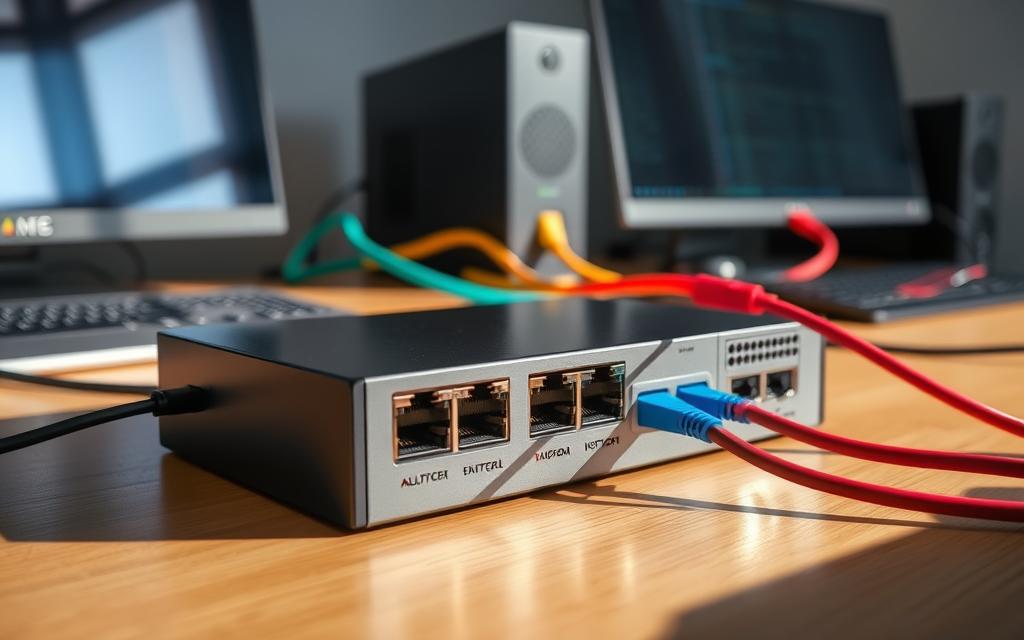
Advantages of a Network Switch
Network switches are better than simple hubs or splitters. They switch packets, giving you faster speeds and less traffic jam. This lets many devices speak together without slowing down.
- They add more connection options with several ports.
- They ensure strong data transfer with minimal loss.
- They allow data to be sent and received at the same time.
Network switches offer dependable and stable connections, crucial for secure data movements. With wired networks often being quicker and less crowded than wireless, choosing a switch makes sense for smooth networking.
Alternative Methods: Ethernet Hubs and Splitters
One might look at using Ethernet hubs or splitters to link many computers to one Ethernet port. These options provide different benefits. Yet, each has limits that might slow down your network.
Using an Ethernet Hub
Ethernet hubs help connect devices by sending out the same data to all. They are good for groups or families with many computers close to each other. With 4 to 12 ports, they are great for small teams. But, their way of sending data to everyone can slow things down when there’s a lot of data moving.
Limitations of Ethernet Splitters
Ethernet splitters can turn one connection into two or more. But, they’re not the best for speedy internet. They often fail to handle lots of data at once, especially on Cat6 or Cat5e cables which have a 100 Mbps limit per split. For high-speed needs, an Ethernet switch might be a better investment.
FAQ
What is the best way to connect two computers to a single Ethernet port?
Using a network switch is the best method. It allows both computers to talk to each other at the same time. This keeps the network running smoothly.
How does an Ethernet hub differ from a network switch?
An Ethernet hub sends data to all devices, causing network slowdowns when busy. On the other hand, a switch sends data only to the device that needs it. This avoids network problems.
Can I use an Ethernet splitter to connect two computers?
You can use an Ethernet splitter, but it’s not a good idea. Splitters can’t handle data from both computers at once. This leads to slower speeds and network problems.
What factors should I consider when assessing my networking needs?
Think about how many devices will need to connect and the speeds they need. Also, consider if you’ll add more devices later. These thoughts will help you choose the right equipment.
What are the advantages of using a network switch over other options?
A network switch is great for fast data transfers and avoiding network slowdowns. It’s perfect for places with many devices needing connections, like offices or homes.
Are there limitations to using Ethernet hubs?
Yes, Ethernet hubs can’t handle lots of devices well. They send data to all devices at once, which can slow down the network. This is not ideal for busy connections.
Is future-proofing important when selecting networking equipment?
Definitely. Choosing equipment that can grow and handle faster speeds is wise. It means you won’t have to replace your setup too soon, saving you time and money.

